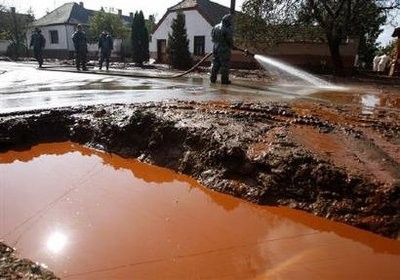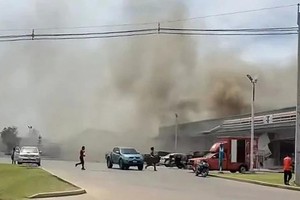Hundreds of rescue workers and volunteers rushed to build a new dam near a chemical plant in western Hungary Sunday amid fears of a new flood of toxic red sludge that forced 1,000 villagers to evacuate their homes.

Repair work also continued on the existing reservoir at an alumina plant where cracks in a wall raised fears of another spill after one on October 4 killed seven people, with one still missing, and wounded about 150 in Hungary's worst environmental disaster.
"The cracks earlier noticed did not widen over Saturday, and their repair is in progress," disaster relief chief Tibor Dobson said.
"At the same time we are building the new dam that will protect Kolontar. The foundation work has been finished. On Sunday our major task is going to be to widen the new dyke and to build it higher," he said.
Kolontar is a stone's throw from the dam from which a two-metre-high (six-and-a-half-feet) flood of foul-smelling red mud poured into into homes, fields and rivers a week ago, with fears the pollution could enter the Danube River that flows on into several European countries.
Around 800 volunteers were helping 900 police, disaster relief workers and firefighters at the site on Sunday, Dobson said.
"We are working on the reconstruction of the dam and also creating many smaller ones on the way to the village so, in case of a new flood, they will slow the sludge," disaster relief services spokeswoman Gyorgyi Tottos told AFP.
About 1,000 people were evacuated from Kolontar and the nearby village of Devecser on Saturday, most taking refuge with friends and relatives in the town of Ajka, 160 kilometres (100 miles) from the capital Budapest, officials said.
About 46 wounded were still in hospital Sunday, Tottos said, most treated for burns from the chemicals which also killed livestock and fish.
"They don't have life-threatening injuries, but some will need plastic surgery," said Jeno Racz, director of the Veszprem county hospital.
"The most serious injuries are second- and third-degreee burns," he told AFP. One person was in a life-threatening condition in another hospital, he said.
A three-year-old boy was also transferred to a Budapest hospital because some of the sludge had entered his eyes, causing serious damage, Racz said.
Between 25 and 30 of the evacuees spent the night in the town's sport's centre, where rows of beds were set up, and told AFP they were worried about their homes, livestock and possessions left behind.
"Unfortunately we will have to stay here for a couple of nights until they build that dam. After that we can hopefully return," said Peter, who like all of those who spent the night at the shelter would only give his first name.
"It is definitely not like home, I am really fed up here. I hardly slept," said Lajos, an elderly evacuee who smoked outside, his face sombre and tired.
Jozsef said his home in Kolontar was among those spared the first flood but he was made to leave in case of the second. "We were not affected by the flood but we had to come here because the whole village was evacuated," he said.
The first wave of sludge from the MAL Hungarian Aluminium Production and Trade Company plant released 1.1 million cubic metres (38.8 million cubic feet) of red mud, a residue from aluminium production which contains toxic heavy metals such as lead, cadmium, arsenic and chromium.
Prime Minister Viktor Orban, who visited the scene on Saturday, warned that the reservoir was so damaged that a second breach was "likely" and it could release 500,000 cubic metres more of the corrosive sludge.
























